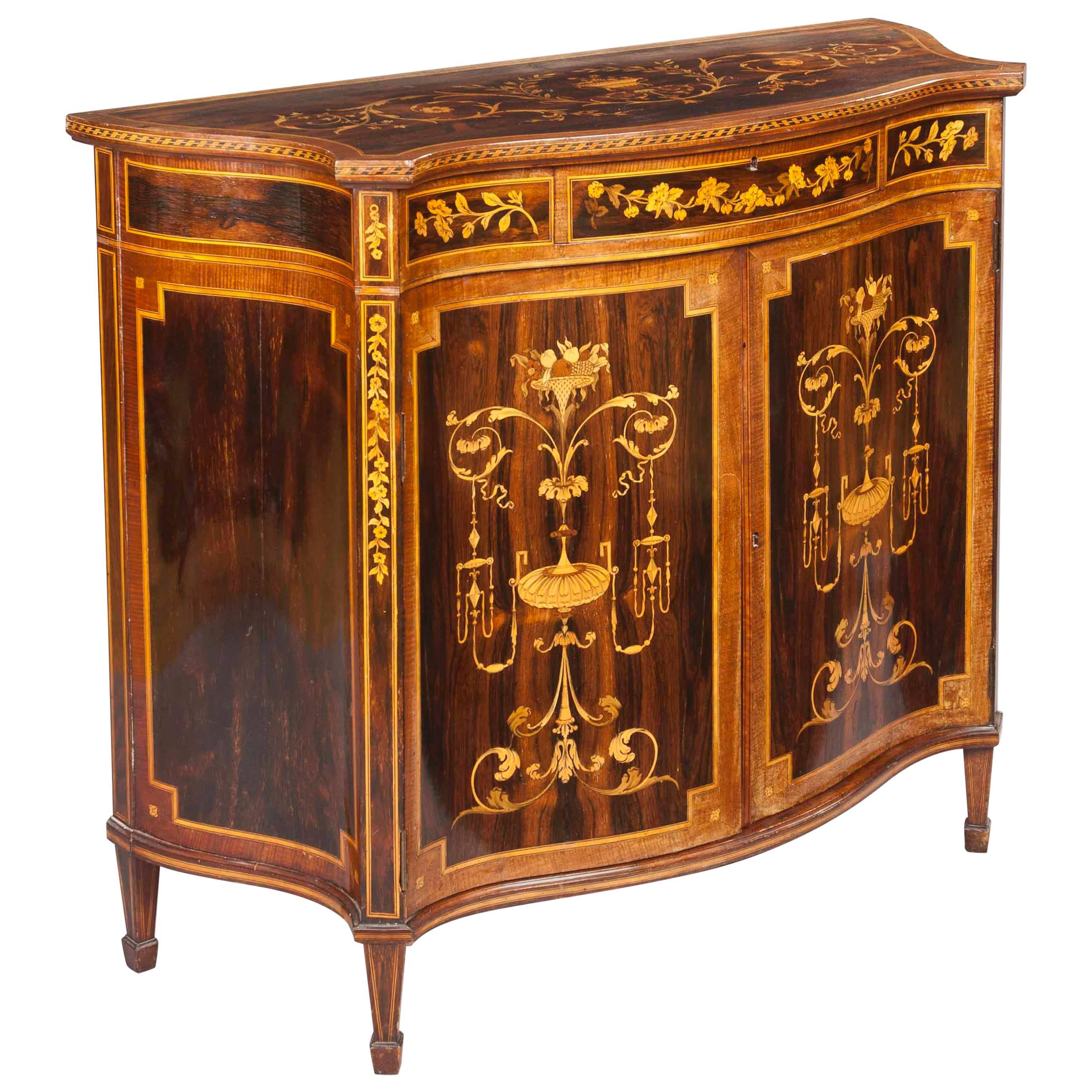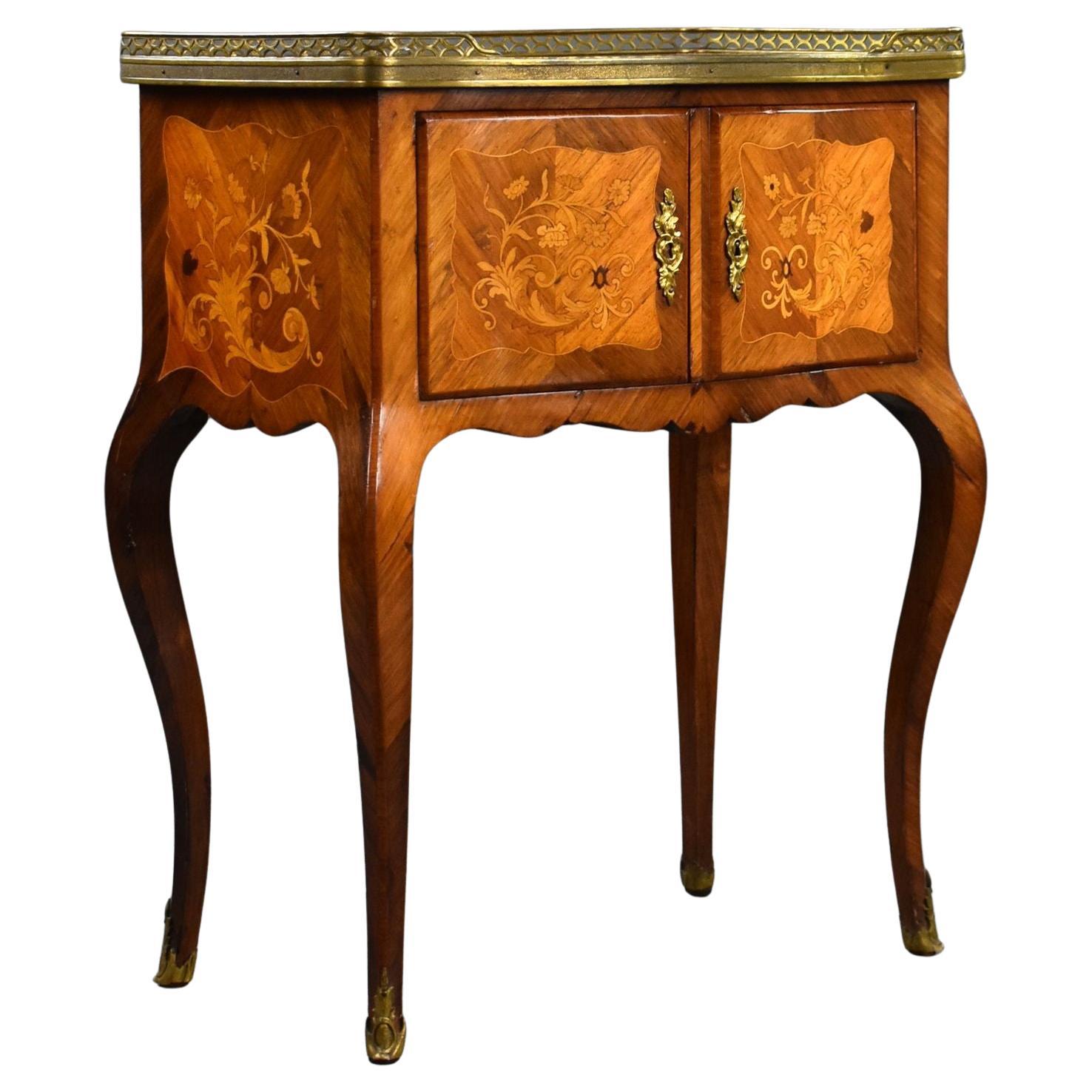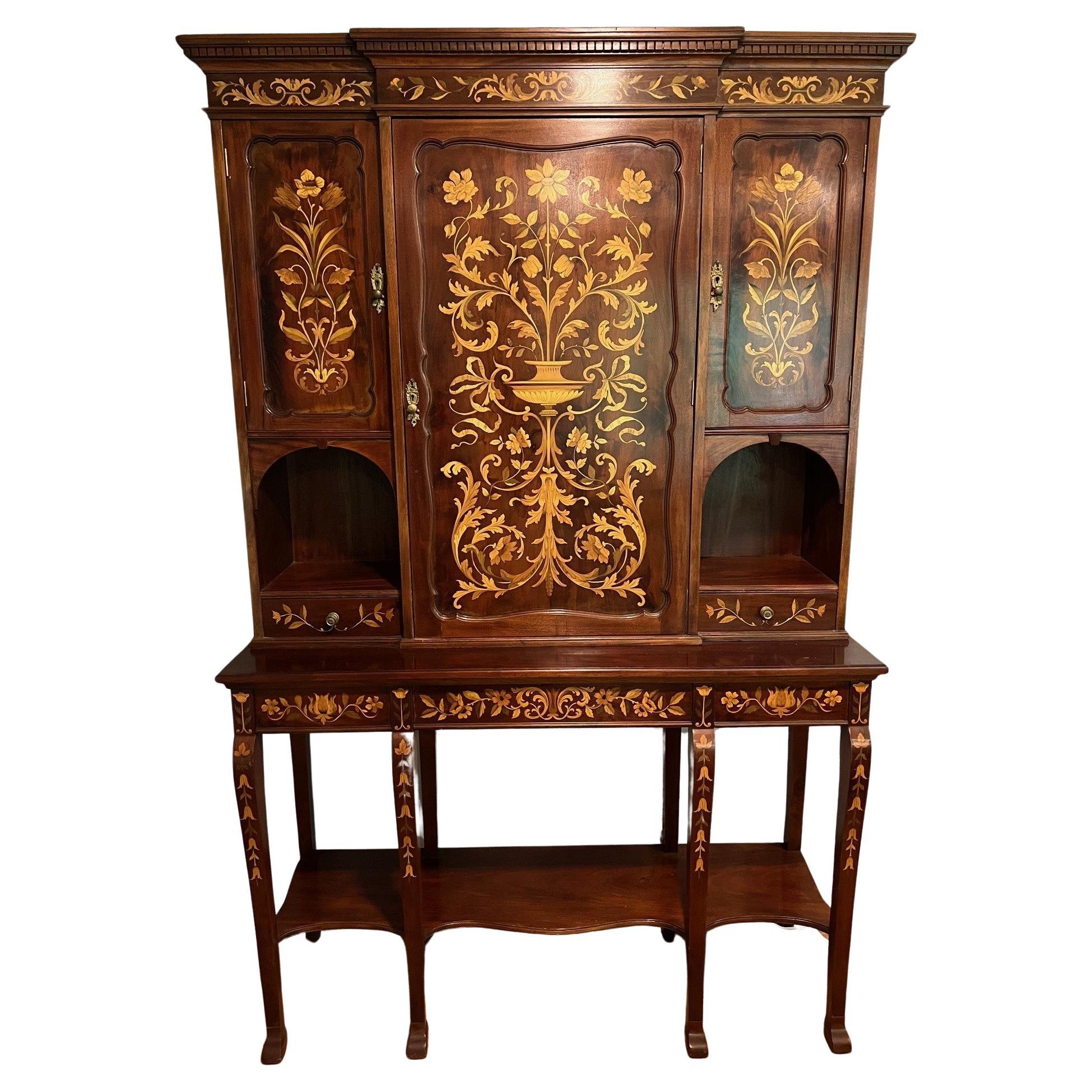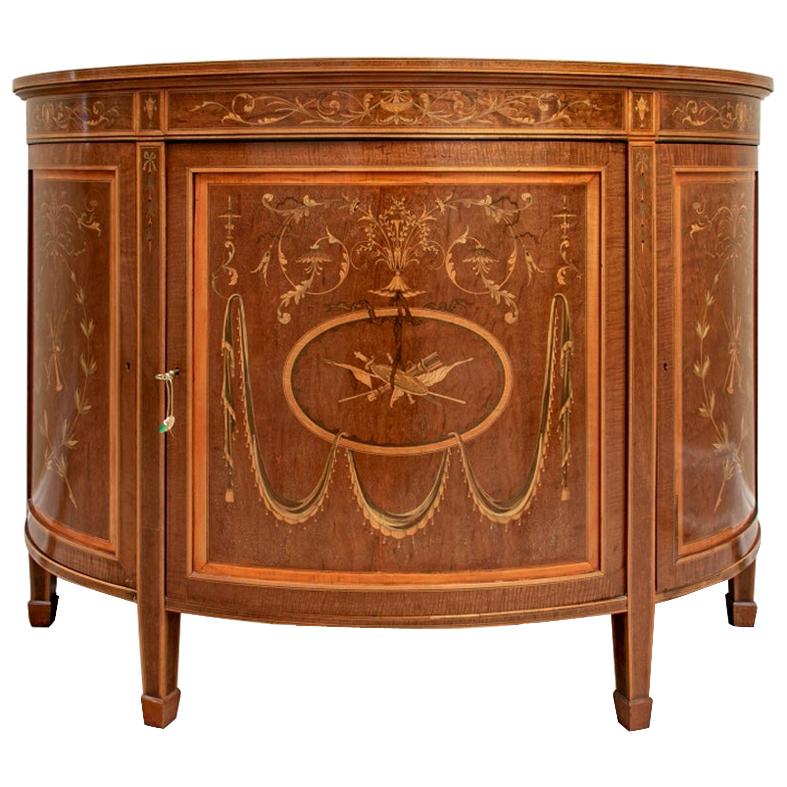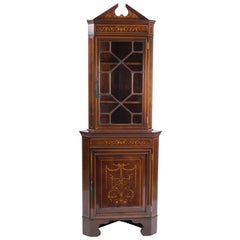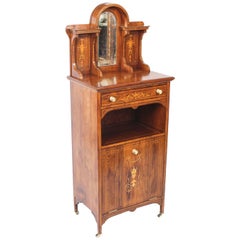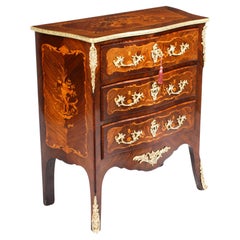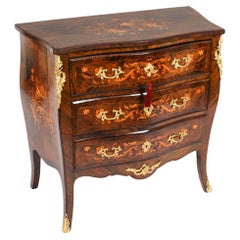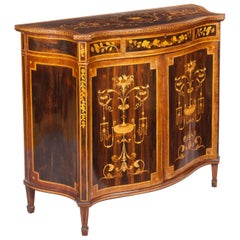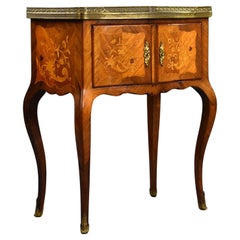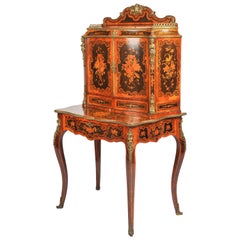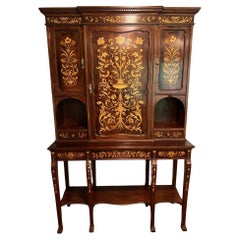Items Similar to Antique Victorian Marquetry Demi Lune Cabinet 19th Century
Video Loading
Want more images or videos?
Request additional images or videos from the seller
1 of 19
Antique Victorian Marquetry Demi Lune Cabinet 19th Century
$3,905.70
£2,850
€3,324.99
CA$5,349.83
A$5,950.18
CHF 3,107
MX$72,407.36
NOK 39,681.12
SEK 37,213.89
DKK 24,815.66
Shipping
Retrieving quote...The 1stDibs Promise:
Authenticity Guarantee,
Money-Back Guarantee,
24-Hour Cancellation
About the Item
This is an elegant antique English Victorian marquetry inlaid demi-lune cabinet, circa 1880 in date.
This splendid cabinet is made of flame mahogany and features beautiful satin wood line inlay with marquetry decoration featuring Cornucopia, floral garlands and foliate scrolls.
The cabinet has two doors above a pair of drawers, and is raised on decorative shaped legs.
Add a touch of unparalleled elegance to your home.
THE BOTANICAL NAME FOR THE MAHOGANY THAT THIS ITEM IS MADE OF IS SWIETENIA MACROPHYLLA AND THIS TYPE OF MAHOGANY IS NOT SUBJECT TO CITES REGULATION AND DOES NOT CONTAIN ANY RESTRICTED MATERIALS.
Condition:
In excellent condition having been beautifully cleaned, polished and waxed in our workshops, please see photos for confirmation.
Dimensions in cm:
Height 104 cm x Width 92 cm x Depth 55 cm
Dimensions in inches:
Height 3 foot, 5 inches x Width 3 foot x Depth 1 foot, 10 inches
Cornucopia Has Latin Origins and Greek History
Cornucopia comes from the Latin cornu copiae, which translates literally as “horn of plenty.” A traditional staple of feasts, the cornucopia is believed to represent the horn of a goat from Greek mythology. According to legend, it was from this horn, which could be filled with whatever the owner wished, that the god Zeus was fed as an infant by his nurse, the nymph Amalthaea. Later, the horn was filled with flowers and fruits, and given as a present to Zeus. The filled horn (or a receptacle resembling it) has long served as a traditional symbol in art and decoration to suggest a store of abundance. The word first appeared in English in the early 16th century; a century later, it developed the figurative sense of “an overflowing supply.”
Flame Mahogany
Thomas Sheraton - 18th century furniture designer, once characterized mahogany as "best suited to furniture where strength is demanded as well as a wood that works up easily, has a beautiful figure and polishes so well that it is an ornament to any room in which it may be placed." Matching his words to his work, Sheraton designed much mahogany furniture. The qualities that impressed Sheraton are particularly evident in a distinctive pattern of wood called "flame mahogany."
The flame figure in the wood is revealed by slicing through the face of the branch at the point where it joins another element of the tree.
Marquetry
is decorative artistry where pieces of material of different colours are inserted into surface wood veneer to form intricate patterns such as scrolls or flowers.
The technique of veneered marquetry had its inspiration in 16th century Florence. Marquetry elaborated upon Florentine techniques of inlaying solid marble slabs with designs formed of fitted marbles, jaspers and semi-precious stones. This work, called opere di commessi, has medieval parallels in Central Italian "Cosmati"-work of inlaid marble floors, altars and columns. The technique is known in English as pietra dura, for the "hardstones" used: onyx, jasper, cornelian, lapis lazuli and colored marbles. In Florence, the Chapel of the Medici at San Lorenzo is completely covered in a colored marble facing using this demanding jig-sawn technique.
Techniques of wood marquetry were developed in Antwerp and other Flemish centers of luxury cabinet-making during the early 16th century. The craft was imported full-blown to France after the mid-seventeenth century, to create furniture of unprecedented luxury being made at the royal manufactory of the Gobelins, charged with providing furnishings to decorate Versailles and the other royal residences of Louis XIV. Early masters of French marquetry were the Fleming Pierre Golle and his son-in-law, André-Charles Boulle, who founded a dynasty of royal and Parisian cabinet-makers (ébénistes) and gave his name to a technique of marquetry employing brass with pewter in arabesque or intricately foliate designs.
Our reference: A4055
- Dimensions:Height: 40.95 in (104 cm)Width: 36.23 in (92 cm)Depth: 21.66 in (55 cm)
- Style:Victorian (Of the Period)
- Materials and Techniques:
- Place of Origin:
- Period:
- Date of Manufacture:Circa 1880
- Condition:
- Seller Location:London, GB
- Reference Number:Seller: A40551stDibs: LU950642077582
About the Seller
5.0
Platinum Seller
Premium sellers with a 4.7+ rating and 24-hour response times
Established in 1983
1stDibs seller since 2012
1,374 sales on 1stDibs
Typical response time: <1 hour
Associations
LAPADA - The Association of Arts & Antiques Dealers
- ShippingRetrieving quote...Shipping from: London, United Kingdom
- Return Policy
Authenticity Guarantee
In the unlikely event there’s an issue with an item’s authenticity, contact us within 1 year for a full refund. DetailsMoney-Back Guarantee
If your item is not as described, is damaged in transit, or does not arrive, contact us within 7 days for a full refund. Details24-Hour Cancellation
You have a 24-hour grace period in which to reconsider your purchase, with no questions asked.Vetted Professional Sellers
Our world-class sellers must adhere to strict standards for service and quality, maintaining the integrity of our listings.Price-Match Guarantee
If you find that a seller listed the same item for a lower price elsewhere, we’ll match it.Trusted Global Delivery
Our best-in-class carrier network provides specialized shipping options worldwide, including custom delivery.More From This Seller
View AllAntique Late Victorian Marquetry Corner Cabinet 19th Century
Located in London, GB
This is a fabulous antique English Edwardian profusely inlaid corner cabinet, circa 1880 in date.
The cabinet is made of rich mahogany and has satinwood inlay with garlands, swags, ...
Category
Antique 1880s British Victorian Cabinets
Materials
Mahogany
Antique Edwardian Gonçalo Alves Marquetry Inlaid Music Cabinet 19th Century
Located in London, GB
This is a beautiful antique Gonçalo alves and boxwood marquetry inlaid music cabinet, circa 1880 in date.
The rectangular top has a mirrored marquetry gallery, above a single friez...
Category
Antique 1880s English Edwardian Cabinets
Materials
Wood, Boxwood
Antique French Louis Revival Marquetry Commode, 19th Century
Located in London, GB
This is a stunning antique walnut, marquetry and ormolu mounted Louis Revival serpentine fronted commode, circa 1880 in date.
The chest has a gonzalo alves cross banded top with d...
Category
Antique 1880s French Commodes and Chests of Drawers
Materials
Ormolu
Antique French Louis Revival Marquetry Commode Chest of Drawers 19th Century
Located in London, GB
This is a stunning antique French Louis Revival marquetry and ormolu mounted wood serpentine commode, circa 1880 in date.
The serpentine top with a moulded edge over three long d...
Category
Antique 1880s French Commodes and Chests of Drawers
Materials
Ormolu
Antique French Louis Revival Walnut Marquetry Commode 19th Century
Located in London, GB
This is a stunning antique French walnut and marquetry Louis Revival bombe commode, circa 1880 in date.
This gorgeous commode features a stunning shaped Rouge Griote marble top ab...
Category
Antique 1880s Commodes and Chests of Drawers
Materials
Walnut
19th Century French Rococo Revival Marquetry Secretaire a Abattant
Located in London, GB
Dating from around 1850, this is a wonderful antique French Rococo Revival Secretaire a Abattant featuring ormolu mounted mahogany, gonzalo alves and marquetry.
A Secretaire a abatt...
Category
Antique 1850s French Rococo Revival Secretaires
Materials
Marble, Ormolu
You May Also Like
19th Century English Marquetry Side Cabinet in the Neoclassical Style
Located in London, GB
A Fine and Decorative Side Cabinet in the Hepplewhite Manner
Constructed in goncalo alves, with satinwood crossbanding and specimen woods used in the inlays; of serpentine form, ris...
Category
Antique 19th Century British Neoclassical Cabinets
Materials
Wood, Satinwood
Antique French Marquetry Side Cabinet
Located in Chelmsford, Essex
For sale is a good quality antique French marquetry side cabinet, of bowed form, with a three quarter pierced brass gallery, having a pair of marquetry inlaid cupboard doors below, s...
Category
Antique 19th Century French Cabinets
Materials
Walnut
19th Century Marquetry Side Cabinet
Located in Brighton, Sussex
A fine quality Victorian marquetry inlaid walnut bonheur-du-jour, having wonderful floral pattern panels to the doors, sides and base, ormolu mounts. The doors open to reveal a shelf...
Category
Antique 19th Century English Victorian Cabinets
Materials
Walnut
19th Century Marquetry Inlaid Cabinet 3 Door 3 Drawer
Located in Stamford, CT
A 19th century antique beautifully inlaid cabinet with three doors and three drawers. This is a magnificent inlaid cabinet with its very detailed inlays. It was French polished and ...
Category
Antique Mid-19th Century European Cabinets
Materials
Wood
Early 19th Century freestanding French marquetry cabinet with a marble top
Located in Martlesham, GB
An unusual and rare early 19th century bow ended freestanding French marquetry marble top cabinet / stand made from tulip wood and inlaid with exotic woods, having the original white...
Category
Antique 1820s French Cabinets
Materials
Tulipwood
Antique George III Style Demilune Satinwood Marquetry Cabinet
Located in Bridgeport, CT
George III satinwood and marquetry cabinet. Satinwood was used as the background for the delicate inlaid marquetry designs. Satinwood, from India, gains its distinctive soft and subt...
Category
Antique Late 19th Century English George III Cabinets
Materials
Satinwood
More Ways To Browse
Mahogany Furniture Antique
English 16th Century Furniture
Victorian Furniture Luxury
Slicer Antique
Victorian Inlaid Cabinet
Inlaid Marquetry Cabinet On Legs
Horn Flowers
Marquetry Wood Inlay Door
Used English Horn
16th Century Brass
Victorian French Doors
Italian Inlaid Wood Marquetry
Flemish Scroll
Demi Lune Cabinet
Demi Lune 18th Century
Antique Boulle
Used Luxury Kitchen Cabinets
Altar Flowers
